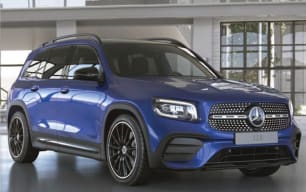Measuring 4638mm long (with a 2829mm wheelbase), 1834mm wide and 1659mm tall, the GLB250 is closer in size to the GLC than the GLA, making it a small SUV on paper only. And that only means good things when it comes to practicality.
For example, cargo capacity with the 50/50 split-fold third row stowed is strong, at 565L, but it can be increased to a massive 1780L with the 40/20/40 split-fold middle bench also out of action. If six or seven seats are in use, though, there's limited space to play with.
That said, the boot is still very well thought out, as evidenced by its massive aperture, lack of a load lip, and flat floor, which make loading bulkier items a lot easier. And yes, its load cover can actually be stored underfloor when not in use!
There are also four tie-down points, two bag hooks, a side storage net and a 12V power outlet to make things that little bit easier, while the rear seats can be operated from behind.
Speaking of which, let's cut straight to the point: Mercedes-Benz claims the third row can accommodate occupants that are up to 168cm tall thanks to the middle bench's ability to slide fore and aft by up to 140mm.
Therefore, my 184cm (6.0ft) frame is a little too tall, but I was still able to sit in the back, albeit not in complete comfort, with about a centimetre of legroom and negligible headroom and toe-room on offer.
The biggest challenge for any occupant is getting in and out in the first place, as the middle bench doesn't tumble forward for easy access. Needless to say, you're not going to look graceful here. Children can learn to deal with it, but adults won't be excited by the prospect.
So, the middle bench is where it's at, even when slid all the way forward. Behind my driving position, it provides about a centimetre of legroom, but this can be increased to a generous 8.0cm by sliding it all the way back.
Either way, plenty of toe-room is available alongside more than an 2.0cm of headroom – and that's with a dual-pane panoramic sunroof fitted.
The second row can accommodate three adults at a pinch, partly thanks to the short transmission tunnel that ensure there's just enough space for three pairs of fully grown feet across the two footwells. Children will be fine.
While we're on the topic, four ISOFIX and five top-tether anchorage points are on hand for fitting up to four child seats across the second and third rows, making the GLB250 a genuine option for families.
In-cabin storage options are numerous, with the central storage bin on the larger side despite housing a pair of USB-C ports, and the glove box is also pretty handy, even if it does have an odd shape. There's also a sunglasses holder in front of the rearview mirror.
The centre console's cubby doesn't lend itself to storage, though, as it's more or less taken up by two cupholders, another USB-C port and a wireless smartphone charger.
The front door bins can take one small and two regular bottles each, while their rear counterparts can carry one small and one regular apiece.
Second-row occupants are further treated to a fold-down armrest with another pair of cupholders, although they're of the retractable (flimsy) variety.
These passengers also have access to two USB-C ports, which fold out below a small cubby and a pair of air vents, which are located at the rear of the front centre console. There are also storage nets on the front seat backrests.
And don't make the mistake of thinking the third row misses out on the action, as two cupholders (one regular, the other small) divide the seats, which have their own USB-C ports and device straps to the sides.

